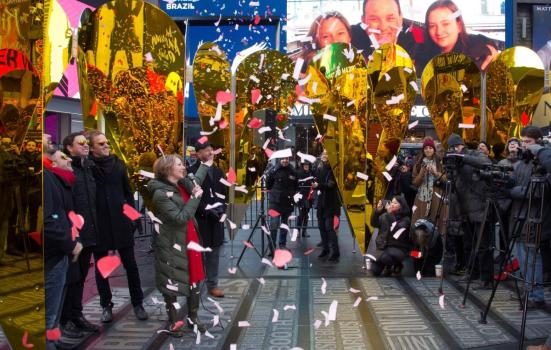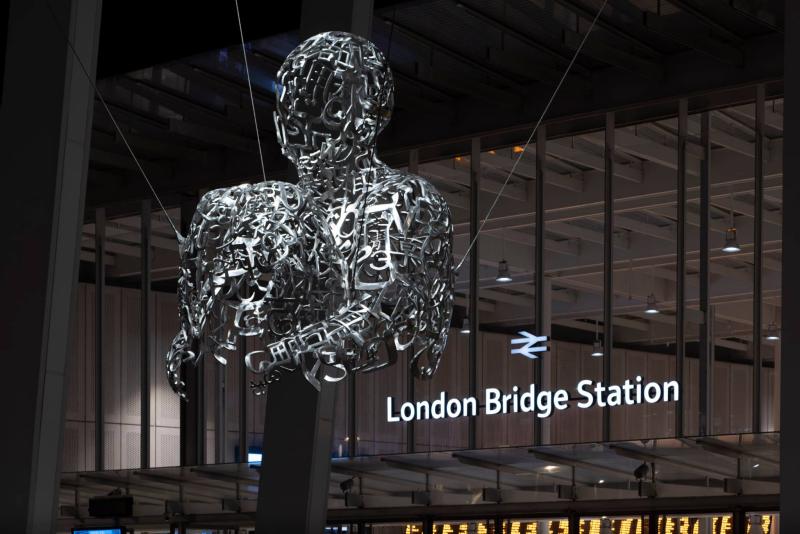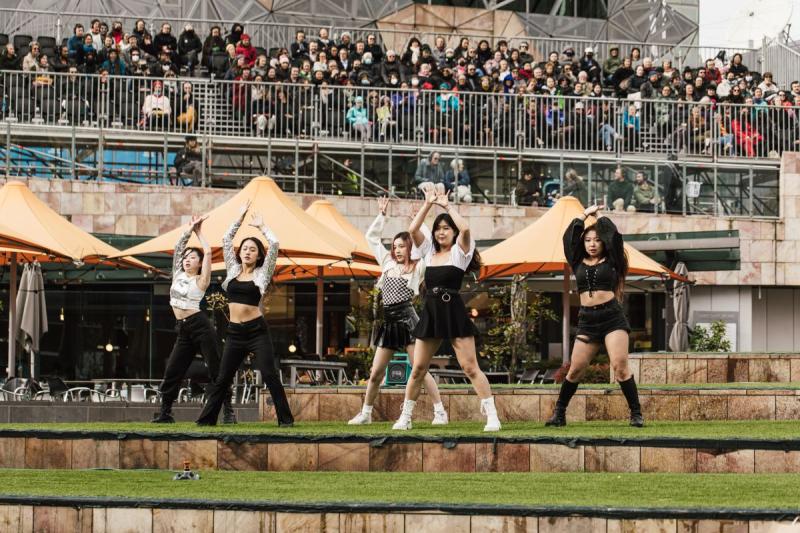The urban development sector is increasingly the first choice of partner for cultural regeneration projects. But how do you find your perfect match? Sherry Dobbin has some matchmaking advice.

ESTO for Times Square Arts
Increasingly, artists and cultural organisations are being encouraged to look for new opportunities - funding, programming support and venues - through the property or urban development sector.
Terms such as regeneration, redevelopment, brownfield site development, rates mitigation, public realm design, community-building, ESG (Environment/Social/Governance) targets… have become expected terminology for the culture and creative industries.
£millions are spent on cultural strategies, planning toolkits and cultural infrastructure frameworks. There are numerous articles about placemaking with artist studios, theatres or galleries, claims of social well-being delivered through ‘arts as a tool’ to fix intangible fabrics of community, and announcements of new developments receiving planning permission with exceptional cultural offer.
The good news is people are discussing the relevance of arts and culture. And for cultural initiatives looking for collaborative creation or organisations looking for venues, other sectors and industries can be an empowering solution.
Challenges looking for solutions
For example, many local authorities assert the importance of cultural provision as a ‘public benefit’ in planning negotiations for any development of commercial and civic property. East Bank in London is a large arts-led regeneration scheme, in which cultural giants such as UAL School of Fashion, V&A and Sadlers Wells are opening new venues as components of the Olympic Park’s sustainability legacy.
By drawing new opportunity for and from surrounding local communities through cultural amenity, East Bank adds to the large outdoor and sporting facilities and provides more opportunity for residents. But not all regeneration or urban development is of the same scale or structure or involves such partnerships.
Many people are involved in generating strategic cultural plans to unlock funds through aligning their shared objectives between different policies, strategies and delivery plans. For example, with transport, well-being, education, skills and employment, and cultural charity objectives.
These cultural strategies and frameworks are a guide for businesses looking for cultural partners and for creatives looking for new resources and opportunities. This is where matchmaking comes in.
Continues ...
 PJaume Plensa, WE, at The Shard, London, curated by Futurecity &Galerie LeLong. Photo: Jonty Wilde
PJaume Plensa, WE, at The Shard, London, curated by Futurecity &Galerie LeLong. Photo: Jonty Wilde
Three types of suitors
A city or region may have a cultural strategy to provide an assessment of an existing cultural identity, as well as to outline potential growth and new partnerships/collaborations. It may suggest investment to connect public and private sectors.
A planning toolkit may demonstrate how a local authority wants culture to be defined and considered in planning applications, as a value which delivers for the community, but funded by private investment.
A Business Improvement District (representing shared interests and costs of local businesses through a mandatory levy to fund things like marketing, promotions and events, town centre management, physical improvements) may commission a cultural strategy to identify programming to increase footfall and attractiveness, produced to a higher standard through pooled resources.
A property developer may commission a cultural strategy to produce a place identity that supports a branding campaign which locates public art, makers’ spaces or venues and the associated commissioning briefs, cultural tenancies, or programming proposals.
These documents all identify the challenges culture can encounter and list priorities. They provide an introductory gateway for your conversation. Where can you be the answer to their problems and where can their investment serve yours?
Funding love languages
Like any great relationship all parties want to feel lucky, independently and together. (“How did I get away with being selfish?” thinks each party). You may have already learned the corporate priorities for sponsorships, naming rights and consultancy services; retail, fashion and food & beverage for brand collaborations; leasing and venue hire practices...
To avoid being frustrated or overwhelmed, approach learning their language with the same curiosity with which dramaturgy, character development, or contextual research excites creative research.
Look at how they operate and express themselves, as well as what they say they are looking for. As with many published matches, the profiles start with what they think they want, but it is in getting to know one another, that you can find the love language(s).
Potential dating profiles
How do you know if these opportunities are right for your needs? Translate any opportunity into a dating profile. Does it seem to match?
Example: Cultural Strategy Referencing Programming Framework
Local Authority Profile (polyamorous): We are looking for artists and companies for architectural competitions; performance festivals in the public realm; artist residencies in our town hall.
Artists/Designers (open relationship or polyamorous): I am looking to showcase performances in the public realm across the city.
--
Example: Pop-up Activations / Temporary Residencies
Business Improvement District (polyamorous): We are looking for creative charities to take pop-up space in our unused shop fronts to mitigate business rates. Some properties share a landlord; some have different landlords.
Design Collective Community Interest Company (open relationship): I am looking for places to showcase our designers, but I would like to have a primary partnership with one landlord.
--
Example: Cultural Anchor Tenancy
Property Developer Profile (monogamous): I am looking for a cultural organisation who can bring a distinctive identity and audience to my place.
Arts Organisation Profile (monogamous): I am looking for a venue that is designed with my organisation embedded in an area with residential community and can front the capital investment.
Grassroots Community Centre in ill repair (monogamous; dating range 1km): I am a Community Interest Company looking for a venue that will match the richness of social programming that has developed in the area for the past 40 years.
--
Example: Public Art Strategy
Property Developer (serial monogamous): We are looking to have a sculpture trail on a reclaimed brownfield site, where a new commission will be installed annually.
Artist (don’t know yet): I am thinking about upscaling my object-based work for public realm.
Continues ...
 Invisible Opera, Sophia Brous for RISING 2022 festival, Melbourne, Australia. Photo: Anne Moffat
Invisible Opera, Sophia Brous for RISING 2022 festival, Melbourne, Australia. Photo: Anne Moffat
Dating advice
Not everyone is the right match. It's important that an artist or organisation understands what their profile should say, and that they ask questions of the financial partner profile to understand values, as well as desired characteristics and shared interests.
It's important to know if they are looking for something a bit more casual (occasional commission or development the property for sale) or a committed relationship (in which they want to know you and build a future together in which your ‘friends and family’ build a larger community).
As with any dating, ask any questions and don’t be afraid to show you may not know their ‘background.’ Be open to a match you may not have knew existed, but never lose your identity and needs in the process.
Sherry Dobbin is a Creative Producer and Founder of SRD Culture Ltd.
![]() sherrydobbin.com
sherrydobbin.com
![]() @sherryrdobbin
@sherryrdobbin




